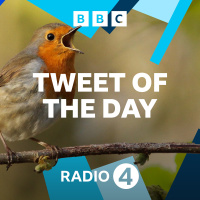Sinopsis
Discover birds through their songs and calls. Each Tweet of the Day begins with a call or song, followed by a story of fascinating ornithology inspired by the sound.
Episodios
-
Christmas Shearwater
25/12/2014 Duración: 01minTweet of the Day is the voice of birds and our relationship with them, from around the world.Sir David Attenborough presents the Christmas shearwater. 2000km south of Hawaii the highly marine Christmas shearwater is at home over the Central Pacific seas, tirelessly riding the air-currents, skimming wave-crests and hugging the contours of the sea looking for food. They rarely come to land as adults, but when they do, it is to return to their place of birth on remote oceanic islands to breed. Here they form loose colonies, laying a single white egg which is incubated for around 50 days. Inhabiting these far flung inaccessible islands means little is known about their biology, but that remoteness gives them protection from land based predators.
-
House Wren
24/12/2014 Duración: 01minTweet of the Day is the voice of birds and our relationship with them, from around the world. Sir David Attenborough presents the house wren found across the New World. Having one of the largest ranges of any songbird in the New World, the migratory house wren occurs anywhere from their breeding grounds in Canada and North America, to their to wintering grounds from Central America to Chile. The male house wren's song is a torrent of trills delivered at full volume from his territory of shrubs, low trees and ferny banks. Diminutive he may be but he's feisty and is known to drag other birds' eggs or chicks from a nest-hole he wants for himself. In parts of North America, house wrens are a significant cause of nest failure in some other species of songbirds.
-
Hyacinth Macaw
23/12/2014 Duración: 01minTweet of the Day is the voice of birds and our relationship with them, from around the world. Sir David Attenborough presents the hyacinth macaw of the Brazilian Pantanal. Raucous ear-piercing screeches are produced by one of the most beautiful parrots in the world, flying high over the marshy wetlands of the Pantanal. As their name suggests they are a rich cobalt blue, with sulphur-yellow eye rings with a massive bill and long elegant tail-feathers streaming behind them in flight, making them our longest parrot. Popular as captive caged birds, they are now endangered in the wild and legally protected in Brazil. They feed on palm nuts, including those of the acuri palm which are so hard that even the macaw's powerful bill can't break into them, until they've first passed through the digestive tracts of cattle. Producer : Andrew Dawes
-
New Zealand Robin
22/12/2014 Duración: 01minTweet of the Day is the voice of birds and our relationship with them, from around the world. Sir David Attenborough presents the New Zealand robin. The toutouwai or New Zealand robin may share a name with the more familiar European robin, but it is a very different bird to the robin redbreast we know so well. Although about the same size with the same perky upright stance, the New Zealand robin, is appropriately enough nearly all-black, with a pale belly and a white splash just above the bill, but no trace of red. Three subspecies exist; one in north Island, one in South Island, and another in Stewart Island. And like their British counterparts, who they are not closely related to at all, can become quite tame and friendly to humans. The song is very varied and each male has a repertoire of around two dozen different notes.Producer : Andrew Dawes
-
Eastern Orphean Warbler
19/12/2014 Duración: 01minTweet of the Day is the voice of birds and our relationship with them, from around the world. Liz Bonnin presents the eastern orphean warbler in an olive grove near Athens. Until recently there used to be just a single species of Orphean Warbler; a summer visitor to southern Europe, North Africa and western Asia: a handsome bird much like a large blackcap with a white throat and greyish-brown back. But across the wide breeding range which stretches from Portugal to Pakistan some orphean warblers look and sound different. Those east of Italy tend to be subtly greyer above and paler beneath. And the songs of birds from Greece eastwards are longer and richer, often including the richness of nightingale like notes. These slight differences have persuaded many ornithologists that the Eastern Orphean warbler is a different species to the Western Orphean Warbler. Biologists call this "splitting "although exactly where these new species boundaries lie is a moot point.Producer : Andrew Dawes
-
Greater Racket-tailed Drongo
18/12/2014 Duración: 01minTweet of the Day is the voice of birds and our relationship with them, from around the world. Liz Bonnin presents the greater racket-tailed drongo of South-East Asia. Across a clearing in a Malaysian forest flies a dark bird, seemingly chased by two equally dark butterflies. Those butterflies in hot pursuit aren't insects at all; they are the webbed tips of the greater racket-tailed drongo's excessively long wiry outer-tail feathers, which from a distance look like separate creatures as it flies. Glossy blue-black birds which live in wooded country and are great insect catchers, hawking after them in mid-air before returning to a perch. They're bold too and won't hesitate to harry and chase much larger birds than themselves, including, birds of prey. Like other drongos the greater racquet-tailed drongo has an extensive but not very musical repertoire which includes the sounds of other birds it meets, when it joins mixed feeding flocks, and can imitate the call of a hawk to alarm the hawk's victims and so st
-
Saddleback
17/12/2014 Duración: 01minTweet of the Day is the voice of birds and our relationship with them, from around the world. Liz Bonnin presents the formerly widespread saddleback of New Zealand. It's loud, piping and whistling calls once resounded throughout New Zealand's forests, but now the saddleback is heard only on smaller offshore islands. This is a bird in exile. About the size of a European blackbird, saddlebacks are predominantly black with a rust-coloured saddle-shaped patch on their backs. In Maori culture this mark came from the demi-God Maui who, after trying to catch the sun, asked the saddleback to fetch water. The bird refused, so hot-handed Maui grabbed it and left a scorch mark on the bird's back. As well as this chestnut saddle, the bird has two bright red wattles at the base of its beak which it can dilate when it displays. It also has an extensive vocabulary and one of its calls has earned it the Maori name –"Ti-e-ke".Producer : Andrew Dawes
-
Blue Manakin
16/12/2014 Duración: 01minTweet of the Day is the voice of birds and our relationship with them, from around the world. Liz Bonnin presents the advancing, leaping and queuing male blue manakin of Brazil. Male blue manakins are small, blue and black birds with scarlet caps. They live in the forests of south-east Brazil and neighbouring areas of Argentina and Paraguay. Whilst their plumage is eye-catching, their mating display is one of the strangest of any bird. A dominant male Blue Manakin enlists the support of one or more subordinate males. Calling loudly, all the males sidle along a branch towards the female, taking turns to leap into the air and then fly back down and take their place at the back of the queue. This sequence of advancing, leaping and queuing occurs at a frenetic pace, until, without warning, the dominant male calls time on this avian dance-off, with a piercing screech.
-
Hawaiian Goose (Nene)
15/12/2014 Duración: 01minTweet of the Day is the voice of birds and our relationship with them, from around the world. Liz Bonnin presents the Nene, or the endemic and rare Hawaiian goose. Visit a Wildfowl and Wetland Trust centre in the UK and it is likely you'll be mobbed by the nasal calls of one of the world's rarest birds, the Hawaiian Goose or "Ne-Ne". In the late 18th century there were around 25,000 of these neat attractive geese, with ochre cheeks and black-heads, on the Hawaiian Islands. But by the early 1950s, due to development and introduced predators, a mere 30 or so remained. A few of these remaining Nene's were taken to Slimbridge, home of Peter Scott's Wildfowl Trust as part of a captive breeding programme. They bred successfully and now many generations of geese produced there have been returned to their native islands. Their future is still precarious in the wild, but as the state bird of Hawaii the Nene's outlook is more secure today than for the last seventy years.
-
Morepork
12/12/2014 Duración: 01minTweet of the Day is the voice of birds and our relationship with them, from around the world. Liz Bonnin presents the morepork or Ru-Ru, New Zealand's only surviving native owl. Strange double notes in the forests of New Zealand were once thought to be cries from the Underworld. But these calls are most likely to be that of a morepork calling. Its familiar call earned it the alternative Maori name of "ruru". Largely nocturnal, it has brown, streaky feathers and large bright yellow eyes which are well adapted for almost silent night hunting forays for large insects, spiders, small birds and mammals. In Maori mythology, moreporks, or "ruru" are spiritual birds, and can represent the ancestral spirit of a family, taking the form of a woman known as "Hine-Ruru" or "owl woman" who acts as a guardian, protecting and advising the family members.
-
Marabou Stork
11/12/2014 Duración: 01minTweet of the Day is the voice of birds and our relationship with them, from around the world. Liz Bonnin presents the gaunt undertaker-looking marabou stork in Africa. It is not very scientific to describe a bird as ugly, but the marabou stork would not win any prizes for beauty or elegance. This bulky stork, with a funereal air, has a fleshy inflatable sac under its throat which conspicuously wobbles as it probes African rubbish dumps for carrion. Seemingly more at home amongst the melee of vultures and jackals squabbling over a carcass, it is known in some areas as the undertaker bird. But, in the air the marabou stork is an elegant sight. It has one of the largest wingspans of any bird, up to 3 metres across. Soaring effortlessly on these broad wings the storks scan the sub-Saharan landscape for food. Marabou storks are doing well, thanks to our throwaway society and they've learned to connect people with rubbish – a salutary association one might say.Producer : Andrew Dawes
-
Northern Jacana
10/12/2014 Duración: 01minTweet of the Day is the voice of birds and our relationship with them, from around the world. Liz Bonnin presents the northern jacana at home in Central American wetlands. A cross between a coot and a plover, northern Jacanas are found in swamps in Central America and Mexico. They're long legged birds with a black head and neck, and a chestnut body with yellow highlights. And, northern jacanas are polyandrous; the females have more than one partner. Males build platforms of floating vegetation and attract females by calling or posturing. If a female mates with a male, he may use his platform as a nest for her eggs. The female doesn't care for the eggs, but goes in search of up to three other mates. The result is that a single female may have several males raising different clutches of eggs for her and each clutch may contain the eggs of more than one male!Producer : Andrew Dawes
-
Black-chinned Hummingbird
09/12/2014 Duración: 01minTweet of the Day is the voice of birds and our relationship with them, from around the world. Liz Bonnin presents the North American black chinned hummingbird. What seems to be a large green beetle is flying erratically across a Los Angeles garden: suddenly, it hovers in mid-air to probe a flower bloom; this is a black-chinned hummingbird. Although often thought of as exclusively tropical, a few species of hummingbirds occur widely in North America and in the west; the Black-chinned hummingbird is the most widespread of all. Both sexes are glittering emerald above: the male's black throat is bordered with a flash of metallic purple, which catches the sun. Black-chinned "hummers" are minute, weighing in at just over 3 grams. But they are pugnacious featherweights seeing off rival males during intimidation flights with shrill squeals, whilst remarkably beating their wings around 80 times a second. They'll also readily come to artificial sugar-feeders put out by householders to attract these flying jewels to t
-
Red-crowned Crane
08/12/2014 Duración: 01minTweet of the Day is the voice of birds and our relationship with them, from around the world. Liz Bonnin presents the red-crowned crane from Japan and Asia. Backlit by a Japanese winter sun, huge black and white birds dance for an audience. Their plumage mirrors the dazzling snow and dark tree-trunks. The only spots of colour are crimson - the caps of these Red-crowned Cranes. Red-crowned Cranes breed only in far-eastern Russia. Tall, majestic and very vocal, red-crowned cranes gather in groups to reinforce pair-bonds, by leaping into the air and fluttering their 2.5 metre wings, sometimes holding sticks or twigs in their long bills. During winter months, the cranes are fed with grain, and receive a stream of captivated visitors. In front of a wall of clicking camera shutters, the cranes perform their elaborate dance, to delight their captivated audience.Producer : Andrew Dawes
-
Brown Thrasher
05/12/2014 Duración: 01minTweet of the Day is the voice of birds and our relationship with them, from around the world.Chris Packham presents the brown thrasher, usually seen in North America. Brown thrashers are related to mockingbirds that breed across most of eastern and central North America. They're famous for their vast repertoire which can include over 1000 song types. They spend much of their time skulking in dense shrubs at woodland edges and in parks and gardens. They're russet on top, white below and heavily streaked like a large thrush but with much longer tails and stout curved bills. Their name comes from the noisy thrashing sound they make as they search the leaf litter for food. Normally, brown thrashers are short distance migrants within North America but in 1966, in November of that year, in Dorset, birdwatchers almost dropped their binoculars in disbelief when they heard the call of a brown thrasher coming from a coastal thicket. It remained here until February 1967 and is the only British record.
-
Red-necked Nightjar
04/12/2014 Duración: 01minTweet of the Day is the voice of birds and our relationship with them, from around the world. Chris Packham presents the nocturnal red-necked nightjar of the Spanish countryside. Like others in the family, red-necked nightjars are nocturnal birds which feed on large insects, snapping them up with huge bristle-lined mouths. A summer migrant, the red-necked nightjar breeds mainly in Spain, Portugal and North Africa. It is closely related to the common European nightjar, but it sounds very different. By day they hide on the ground among scrub where their cryptic patterns provide excellent camouflage. They're the colour of mottled bark and as you'd expect from their name, have a rusty-red collar. As the sun sets, they emerge from their hiding places to glide and turn on slender wings through scrub and pinewoods, occasionally warning rivals by clapping their wings together over their backs with a sound like a pistol-shot. Between bouts of moth-chasing, they settle on a pine branch and pour forth their repetitive
-
Atlantic (Island) Canary
03/12/2014 Duración: 01minTweet of the Day is the voice of birds and our relationship with them, from around the world. Chris Packham presents the Atlantic canary singing in the Tenerife treetops. The ancestor of our cage-bird canaries is the Island or Atlantic Canary, a finch that is native to the Azores, Madeira and Canary Islands, which include Tenerife. The Canary Islands were named by early travellers "the islands of dogs from 'canis', the Latin for dogs, because of the many large dogs reputedly found there. And so the common and popular song-bird which is now a symbol of the islands became known as the canary. Unlike their domestic siblings, wild Island canaries are streaky, greenish yellow finches: males have golden- yellow foreheads, females a head of more subtle ash-grey tone. But it's the song, a pulsating series of vibrant whistles, trills and tinkling sounds; that has made the canary so popular. They were almost compulsory in Victorian and Edwardian parlours; a far cry from the sunny palm -fringed beaches of the Atlanti
-
Greater Rhea
02/12/2014 Duración: 01minTweet of the Day is the voice of birds and our relationship with them, from around the world. Chris Packham presents the greater rhea roaming the South American pampas. Greater rheas are the largest birds in South America and look like small brown ostriches. They're flightless, but can avoid danger by sprinting away on sturdy legs reaching speeds of up to 60 kilometres per hour. Gauchos, the horsemen of the pampas, used to hunt them on horseback using a bolas; a well-aimed bolas would wrap around the rhea's legs or neck and bring it down in a tangle of feathers and limbs. In the breeding season males call loudly to proclaim territories, and to woo potential mates the male runs around erratically, spreading his wings and booming. He mates with several females who lay their eggs in the same nest. Then the females depart to mate with another male leaving the first male to incubate the clutch and rear the huge brood of chicks on his own.
-
Wedge-tailed Shearwater
01/12/2014 Duración: 01minTweet of the Day is the voice of birds and our relationship with them, from around the world. Chris Packham presents the wedge-tailed shearwater of the Indian and Pacific oceans. Wedge-tailed shearwaters are large sepia brown seabirds with long wings and streamlined bodies. They feed mainly on fish and squid which they scoop from the surface or catch by diving. While the parents are careering over the open seas, their solitary chick squats alone in its island burrow. The return of the adults means a welcome feast for the chick. Its reward is a mouthful of warm and waxy stomach oil, the digested remains of the adults prey. It may sound revolting to us, but this oil is rich in energy and allows the chick to grow even bigger than its parents before losing weight again prior to its first flight, which happens a few weeks after the adult birds have abandoned it to its fate.
-
Madagascar Harrier-hawk
28/11/2014 Duración: 01minTweet of the Day is the voice of birds and our relationship with them, from around the world. Chris Packham presents the Madagascan Harrier-hawk from Madagascar. Among the branches of a Madagascan forest, there's a flutter of wings and a flash of double-jointed feet. The Madagascan harrier-hawk is a striking bird, uniform grey above and finely barred beneath with black wing-tips and a white-banded black tail. There's a patch of sulphurous skin around its bill and eyes: and its long legs are also bright yellow. Those long legs help the harrier-hawk hunt for food that's beyond the reach of most other birds of prey. Using its wings for balance and twisting its flexibly jointed legs at seemingly impossible angles, the harrier-hawk inserts its talons into tiny holes, relying on its sense of touch to locate its prey. Madagascan Harrier-hawks do hunt more conventionally by gliding over the forest, seizing small birds, reptiles and mammals such as the Verreaux's sifaka.














